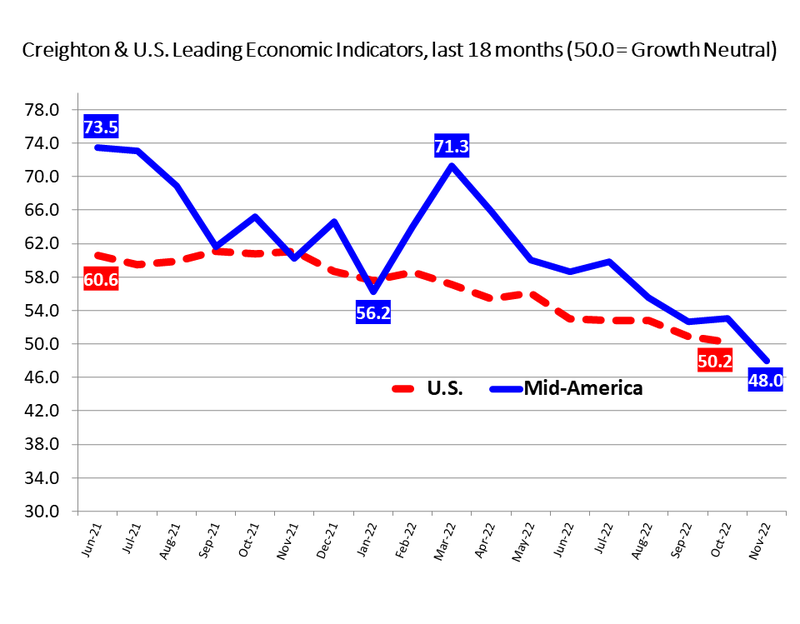Survey: Business forecast dimming for region that includes Nebraska

OMAHA — For the first time in 30 months, an index used by Creighton University to gauge the economic health of a nine-state region including Nebraska has dropped below growth neutral.
That sends up “flashing recession warnings” for the first half of 2023, said Ernie Goss, director of Creighton’s economic forecasting group.
Nebraska falls, overall
Each month the forecasting group updates its Mid-America Business Conditions Index, which is based on survey responses from supply managers stretching from Minnesota to Arkansas.

Results released Thursday showed that the overall index, or business barometer, dipped from 53 in October to 48 in November. On a scale of zero to 100, 50 is growth neutral.
For Nebraska specifically, the overall state reading fell below growth neutral for a third consecutive month, dropping from 43.2 in October to 42.8 in November.
Components of the index, in Nebraska, include: production or sales, which scored 45.9; inventory, 39.7; employment, 31.7; and new orders, 46.9.
Regionally, Goss said the manufacturing sector is showing weakness, indicating a potential recession.
‘Rearing its ugly head’
He said that across the nine states, the latest overall index is the lowest it has been since May 2020, at the beginning of the COVID-19 pandemic.
“We asked about the greatest threats looking forward to the rest of 2022 and into 2023, and No. 1 by far was higher input prices,” said Goss. “Inflation is still rearing its ugly head out there, according to supply managers.”
Supply managers also expressed concerns about a recession, supply chain disruptions, higher interest rates and labor shortages. Indeed, 65% of the firms reported a shortage of job applicants for available jobs.
Not since the early months of the pandemic, June and July of 2020, has the survey registered two straight months of job losses — as a region.
However, Goss said, a look at job numbers by individual states shows Nebraska among four of the nine with employment readings back above pre-pandemic levels.
(The others with non-farm employment higher compared to pre-COVID are Arkansas, Missouri and South Dakota.)
Confidence rises slightly
He said that according to the U.S. Bureau of Labor Statistics, private wages in Nebraska expanded over the past year by 4.1%, and manufacturing wages climbed by 6.2%.
Survey responses showed a slight rebound in economic optimism, as captured by the business confidence index going from 18.5 in October to the current 25. Goss said he considered that number to still be weak.
“Confidence indices for each month in 2022, all below growth neutral, are the worst string of readings since the 2008-09 recession,” he said.








